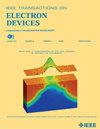GaN-Based Freestanding Micro-LEDs With GHz Bandwidth and Low Efficiency Droop for Visible Light Communication
IF 2.9
2区 工程技术
Q2 ENGINEERING, ELECTRICAL & ELECTRONIC
引用次数: 0
Abstract
Visible light communication (VLC) based on micro light-emitting diodes (micro-LEDs) offers energy-efficient methods for explosive data transmission. However, the severe quantum-confined stark effect (QCSE) and carrier localization make it challenging for micro-LEDs to achieve both high modulation bandwidth and high external quantum efficiency (EQE). Herein, GaN-based freestanding micro-LEDs with varying quantum barrier (QB) thicknesses were designed and fabricated. The thinner QBs effectively reduce the QCSE and improve carrier transport, resulting in high modulation bandwidth and less efficiency droop. Homoepitaxial growth of micro-LEDs gives birth to further improved modulation bandwidth and optical power due to lower defect density and improved thermal dispassion. The −3 dB bandwidths of the 10 and基于氮化镓的独立式微型 LED,具有 GHz 带宽和低效率骤降,适用于可见光通信
基于微型发光二极管(micro-LED)的可见光通信(VLC)为爆炸性数据传输提供了节能方法。然而,严重的量子约束效应(QCSE)和载流子局域化使得微型发光二极管在实现高调制带宽和高外部量子效率(EQE)方面面临挑战。在此,我们设计并制造了具有不同量子势垒(QB)厚度的氮化镓基独立微型 LED。较薄的量子势垒可有效降低 QCSE 并改善载流子传输,从而实现较高的调制带宽和较低的效率下降。由于缺陷密度更低,热分散性更好,微型 LED 的同向外延生长进一步提高了调制带宽和光功率。直径分别为 10 和 20~\mu $ m 的独立式微型发光二极管的 -3 dB 带宽分别超过了 1.03 GHz 和 823 MHz。在直径为 20~\mu $ m 的器件上实现了 5.54 mW 的高光功率和 4.08 Gb/s 的数据传输速率,同时保持了 4.17% 的相对较高的 EQE。所提出的方法系统地提高了调制带宽和发光效率,证明了自由空间 VLC 的巨大潜力。
本文章由计算机程序翻译,如有差异,请以英文原文为准。
求助全文
约1分钟内获得全文
求助全文
来源期刊

IEEE Transactions on Electron Devices
工程技术-工程:电子与电气
CiteScore
5.80
自引率
16.10%
发文量
937
审稿时长
3.8 months
期刊介绍:
IEEE Transactions on Electron Devices publishes original and significant contributions relating to the theory, modeling, design, performance and reliability of electron and ion integrated circuit devices and interconnects, involving insulators, metals, organic materials, micro-plasmas, semiconductors, quantum-effect structures, vacuum devices, and emerging materials with applications in bioelectronics, biomedical electronics, computation, communications, displays, microelectromechanics, imaging, micro-actuators, nanoelectronics, optoelectronics, photovoltaics, power ICs and micro-sensors. Tutorial and review papers on these subjects are also published and occasional special issues appear to present a collection of papers which treat particular areas in more depth and breadth.
 求助内容:
求助内容: 应助结果提醒方式:
应助结果提醒方式:


